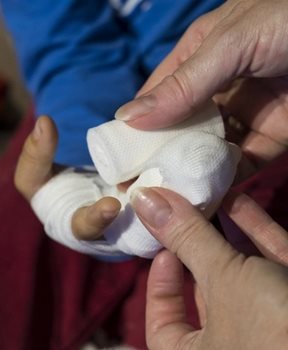By Vanessa Racine, social medias coordinator
Even when we take steps to prevent injuries, we know sometimes things just happen. With children enjoying the outdoors, there are some summertime-specific injuries to be aware of, and what you can do when they happen.
 Better safe than sorry!
Better safe than sorry!
It’s always best to prevent injuries before they happen. To do that, it’s essential that you keep a watchful eye and outfit children with the equipment they need to have fun safely. For tips on prevention, read this article. (Put the link to the article: Preventing summer injuries)
First aid ready
Keep a first aid kit readily available in your home, cottage, car, boat, workplace, and recreation area. Store it in a dry place and replace used or expired items regularly. Here's what should go in a
first aid kit.
Cuts and scrapes
- Bleeding is usually minimal with cuts and scrapes, but if the wound is bleeding heavily, apply direct pressure until it stops.
- If possible, rinse the wound for 5 minutes with clean running water.
- If an antibiotic ointment or cream is available, ask the person whether they are sensitive to any antibiotics, such as penicillin. If not, suggest that the person apply ointment to the wound.
- Cover the wound with a sterile non-stick dressing or bandage.
- Ensure that the person knows to watch for signs of infection over the next few days.
Puncture wounds
- If the wound is bleeding, apply direct pressure until the bleeding stops.
- Once the bleeding is under control, wash the wound thoroughly with water. If possible, rinse the wound for 5 minutes with running water.
- Cover the wound with a sterile dressing or bandage.
- Ensure that the person knows to watch for signs of infection over the next few days.
Bruises
- Using ice or another cold source, cool the injured area to help reduce pain and swelling. Place a cloth, towel or pad between the cold source and the skin to avoid freezing the skin.
- Apply the cold compress to the bruise for 20 minutes, and then wait 20 to 30 minutes before reapplying. Continue for as long as the person keeps feeling pain.
Splinters
- Gently grab the exposed end of the splinter with tweezers and carefully pull it out.
- Rinse the affected area with water and cover it with a bandage.
Nosebleeds
- Ask the person to sit down, tilt their head slightly forward, and pinch their nostrils for 10 to 15 minutes. If the nosebleed was caused by a severe head injury, do not pinch the nose.
Superficial burns
- Slow the progress of the burn by cooling the affected area with clean running water or placing the affected area in a container of clean water for at least 10 minutes. A clean compress that is cool or cold (but not freezing) can be used as a substitute.
When to call EMS/9-1-1
At times, you may be unsure if you need to call for help. When in doubt, make the call. If you think that an emergency exists, it probably does; you should call EMS/9-1-1 for professional help immediately.
Enjoy all that summer has to offer… safely!
Related stories: